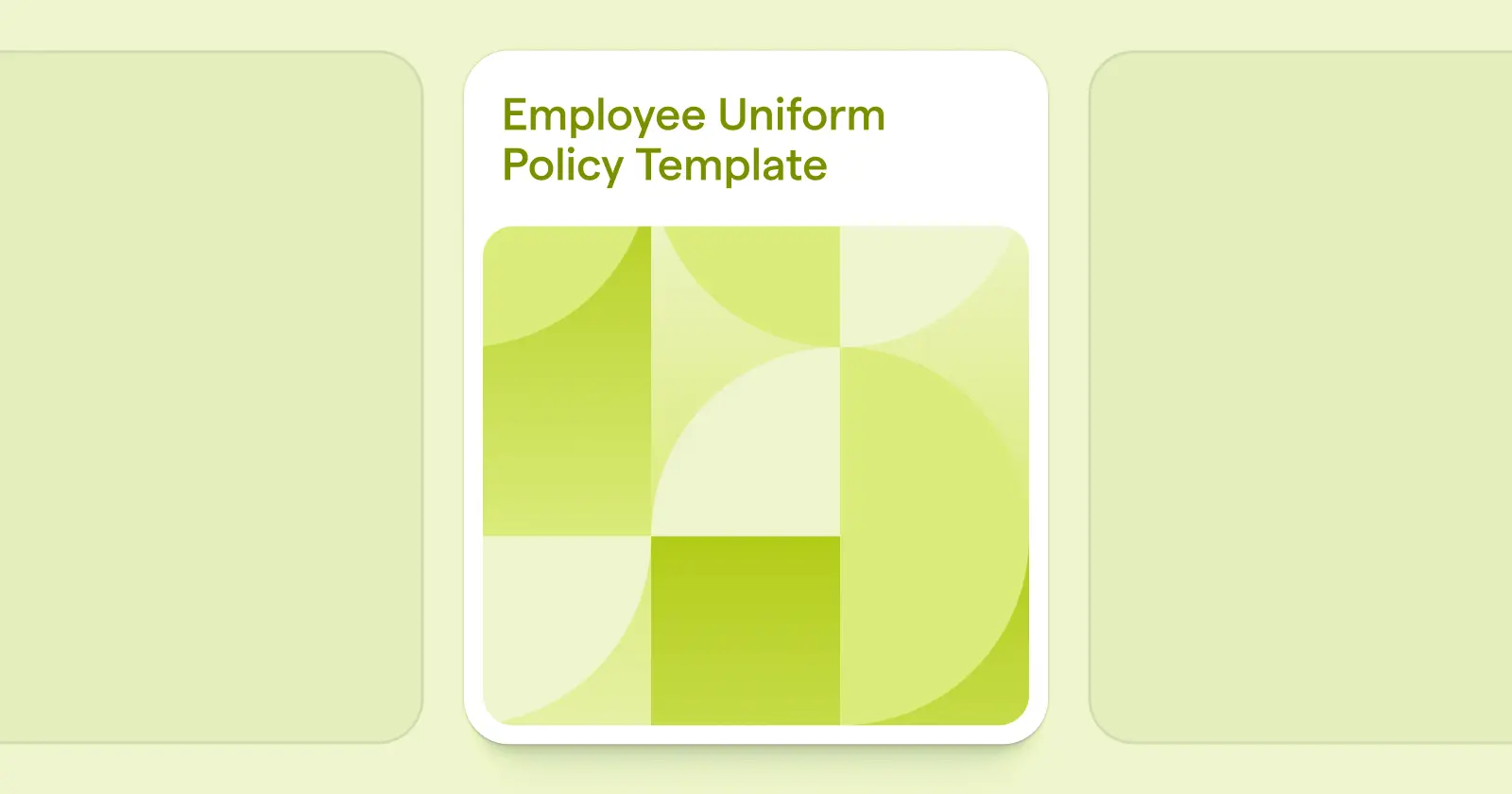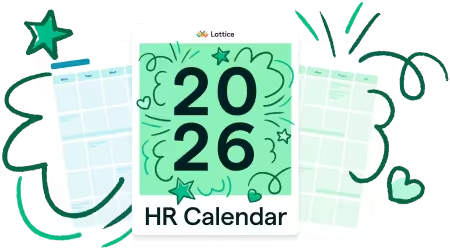Employee Uniform Policy Template


Download this template for free
By submitting your information, you agree to Lattice's Terms of Service and Privacy Policy. You can opt out anytime.
Thanks! We'll be in touch soon.
Whether employees interact directly with customers, work in physical environments, or represent the company in the field, a clear employee uniform policy helps set expectations and reduce confusion.
This policy is intended for businesses in industries where uniforms are required, and clarifies what employees are expected to wear and how the company supports uniform access and maintenance. It also reinforces the importance of safety, inclusivity, and respect when it comes to workplace appearance.
What the Uniform Policy Should Include
A strong and inclusive uniform policy should clearly explain:
- Purpose and scope: Why the policy exists and which employees it applies to
- Uniform requirements: What is required, optional, or restricted in terms of clothing, footwear, and accessories
- Roles that require uniforms: Frontline, customer-facing, safety-sensitive, etc.
- Grooming and appearance standards: If applicable, guidelines on neatness or hygiene (applied respectfully)
- Religious, medical, or cultural accommodations: Process for requesting modifications to the dress code
- Uniform distribution: How and when uniforms are provided and replaced
- Responsibility for cleaning or care: What the company provides and what employees are expected to maintain
- Consequences of noncompliance: Progressive discipline, with opportunities for correction
- Legal compliance: Reference to labor laws, OSHA requirements, and anti-discrimination policies
Purpose of the Employee Uniform Policy
This policy exists to ensure that employees:
- Are dressed appropriately for the demands of their role
- Present a consistent, professional appearance to clients, customers, and the public
- Maintain safety, hygiene, and compliance standards based on their work environment
- Understand their responsibilities when it comes to company-issued clothing or uniform requirements
Uniforms should reflect the company’s culture while supporting employee comfort, inclusion, and confidence at work.
Sample Employee Uniform Policy
{{rich-highlight-1}}
Effective Date: [Insert Date]
Policy Owner: People Team / Operations / Facilities
Last Reviewed: [Insert Date]
1. Policy Overview
This policy outlines the standards for uniforms and personal appearance for employees in roles that require a specific dress code. These standards are designed to promote safety, professionalism, brand consistency, and a respectful workplace environment.
Uniform expectations vary by role and department, and will be communicated during onboarding or role transitions.
2. Who This Policy Applies To
This policy applies to employees in the following categories:
- Frontline or customer-facing roles
- Field-based or delivery roles
- Manufacturing, warehouse, or facilities-based positions
- Food service, healthcare, or other regulated industries
- Any role where uniforms are required for safety, compliance, or branding
Employees in administrative or corporate roles may be subject to a separate dress code or casual workplace policy.
3. Uniform Standards and Requirements
Employees in uniformed roles are required to wear:
- Company-issued shirts, jackets, or other branded items specific to their department
- Closed-toe or safety-approved footwear as required by the work environment
- Identification badges or name tags (if applicable)
- Appropriate bottoms (e.g., black pants, khakis, or job-specific requirements)
All clothing must be clean, in good condition, and fit appropriately. Uniforms should not include excessive wear, stains, rips, or unauthorized alterations.
4. Grooming and Appearance
Employees are expected to present a clean, professional appearance while on duty. This may include:
- Maintaining good personal hygiene
- Keeping hair neat and safely secured (if required for the role)
- Minimizing heavily scented products or fragrances in shared spaces
- Following any applicable food handling, healthcare, or safety-related grooming standards
[Company Name] respects individual expressions of identity. Grooming standards will be applied equitably and with sensitivity to cultural, religious, and gender diversity.
5. Religious and Medical Accommodations
Employees who need adjustments to the uniform policy for religious, medical, or disability-related reasons should contact the People Team. Reasonable accommodations will be made in accordance with federal and state law.
Examples include:
- Religious head coverings
- Adaptive clothing or shoes for medical needs
- Exceptions to grooming requirements based on religious observance
All requests will be handled confidentially and without retaliation.
{{rich-highlight-3}}
6. Uniform Issuance and Replacement
The company will provide employees with an initial set of uniforms at no cost, which may include:
- 2–5 shirts or tops
- 1 jacket or outerwear item
- Additional items depending on the role (e.g., apron, hat, gloves)
Uniforms will be replaced due to normal wear and tear or size changes. Lost or damaged items due to negligence may need to be replaced at the employee’s expense.
Replacement requests should be submitted to [Insert department or contact].
7. Cleaning and Maintenance
Employees are expected to maintain the cleanliness and appearance of their uniforms unless otherwise specified. For roles that require heavy-duty laundering, [Company Name] may provide on-site laundry services or reimburse cleaning expenses.
Any items that become unwearable should be reported to a supervisor as soon as possible.
8. Unauthorized Modifications or Accessories
Employees should not:
- Add non-approved logos, slogans, or embellishments to uniforms
- Wear visible political or offensive messages while in uniform
- Pair uniforms with inappropriate accessories (e.g., sandals in safety zones)
- Modify uniforms in a way that violates safety, cultural, or branding guidelines
Questions about what is or isn’t allowed should be directed to the People Team.
9. Noncompliance and Discipline
Employees who do not follow the uniform policy may be:
- Asked to return home to change
- Given a verbal or written warning
- Subject to progressive disciplinary action for repeated violations
The goal is always to resolve issues respectfully and collaboratively. Managers will address uniform concerns in private, with guidance from HR as needed.
10. Policy Review and Updates
This policy will be reviewed at least annually or when roles, uniforms, or branding standards change. Employees will be notified of any updates, and changes will be reflected in onboarding and team-specific training materials.
Frequently Asked Questions
1. Do I have to wear a uniform if I work remotely?
No. Remote or hybrid roles typically follow a separate dress code policy. Uniforms apply only to designated roles that require in-person presence.
2. What if I lose or damage my uniform?
Contact your manager or the People Team right away. We’ll help coordinate a replacement. You may be responsible for costs if the damage was due to negligence.
3. Can I wear personal clothing under my uniform?
Yes, as long as it doesn’t interfere with safety, visibility, or branding. For example, long sleeves under a short-sleeved uniform shirt are usually acceptable.
4. What if I can’t afford the uniform pieces required?
Uniforms are provided at no cost. If you need additional items or help with sizing, reach out to HR — we’re here to support you.
5. What if I feel a uniform policy violates my religious or cultural beliefs?
We take all requests seriously and are committed to reasonable accommodations. Please contact the People Team so we can find a solution together.
{{rich-highlight-2}}
🚩 Please note: This sample policy is for informational purposes only and does not constitute legal advice. It is a generic template that may not suit your specific circumstances. When adopting or revising a policy, consult legal counsel to ensure compliance with applicable labor, safety, and anti-discrimination laws.
✨ Disclaimer: This resource was developed with the help of artificial intelligence, though reviewed, edited, and approved by (real) humans.
Frequently Asked Questions

Your people are your business
Ensure both are successful with Lattice.





.webp)